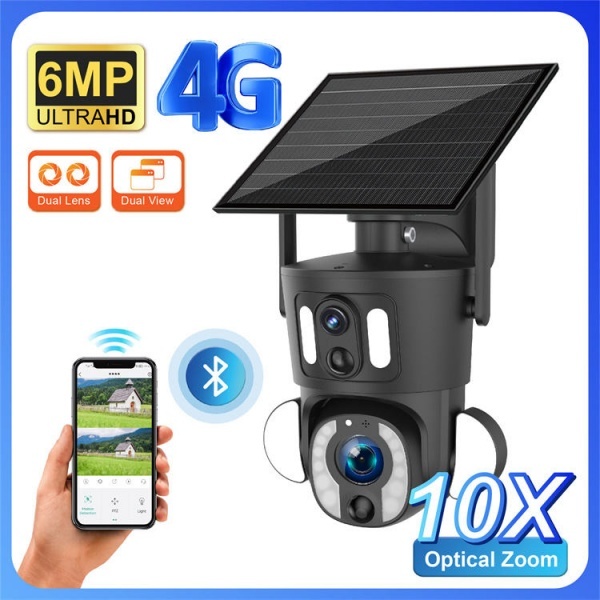Border and Frontier Surveillance: The Reliability of Solar Cameras in Extreme Environments
Monitoring vast, remote, and often inhospitable borders presents one of the most significant challenges in modern security. These frontiers are characterized by a complete lack of infrastructure—no power grid, no wired internet, and exposure to some of the planet’s harshest weather. For security integrators, government agencies, and telecom operators, deploying effective surveillance in these areas has traditionally been a logistical and financial nightmare.
The core pain point is dependency. Traditional systems depend on a power grid that doesn’t exist and communication lines that are impossible to lay. This is where the paradigm shifts. As an engineer with over a decade of hands-on experience in this field, I’ve seen firsthand how solar-powered 4G security cameras have evolved from a niche concept into a robust, mission-critical solution for off-grid surveillance.
Why Traditional Surveillance Fails at the Frontier
Before appreciating the innovation of solar cameras, it’s crucial to understand the inherent flaws of conventional systems in remote settings. Grid-powered cameras require extensive and costly trenching to lay power and data cables across miles of difficult terrain. This initial investment is massive, and the infrastructure remains vulnerable.
A single power outage, a common occurrence in remote regions, can disable entire sections of the surveillance network. Maintenance is another hurdle; accessing and repairing damaged cables or hardware in mountains, deserts, or dense forests is a slow and expensive process. These systems are simply not designed for the autonomy and resilience required for border security.
The Engineering Behind Extreme Environment Reliability
The dependability of a solar security camera in a place where temperatures can swing from -20°C to 50°C (-4°F to 122°F) isn’t accidental. It’s the result of meticulous engineering focused on three core pillars: power management, physical durability, and data connectivity.
Power System Resilience (BMS): The heart of a solar camera is its battery and the intelligence that governs it. A sophisticated Battery Management System (BMS) is non-negotiable. It does more than just charge and discharge; it protects the battery cells from over-voltage, under-voltage, and, critically, temperature extremes. Our BMS technology, for example, prevents charging below freezing to avoid irreversible damage, ensuring the longevity of the entire system. You can learn more about why BMS is a key technology for solar camera protection.
Ingress Protection & Material Science: A camera on a border post is constantly under assault from the elements. An IP66 or IP67 rating is the minimum standard, guaranteeing the housing is sealed against dust ingress and powerful jets of water or even temporary immersion. We utilize industrial-grade, UV-stabilized polycarbonate and metal alloys that won’t become brittle in the cold or warp in the desert sun, ensuring the internal components remain protected year after year.
Uninterrupted 4G Connectivity: In remote areas, Wi-Fi is not an option. A reliable 4G LTE connection is the lifeline for real-time video feeds and alerts. Our cameras are engineered with high-gain antennas and multi-carrier support to capture and maintain stable signals even in fringe coverage zones. This independent connectivity makes each camera a self-sufficient security outpost. Understanding the differences between 4G vs. Wi-Fi solar cameras is crucial for planning remote deployments.
Core Technology Comparison: Solar vs. Traditional Border Cameras
For B2B clients like wholesalers, brand owners, and security contractors, the choice comes down to performance and total cost of ownership. The advantages of a solar-powered 4G solution become starkly clear when compared directly.
| Feature | Solar-Powered 4G Cameras | Traditional Wired Cameras |
|---|---|---|
| Power Source | Independent (Solar Panel & Battery) | Dependent on Electrical Grid |
| Connectivity | Wireless (4G LTE Cellular) | Wired (Ethernet/Fiber Optic) |
| Deployment Speed | Rapid (Hours) | Slow (Weeks or Months) |
| Initial Cost | Moderate (per unit) | Very High (due to trenching/cabling) |
| Operational Cost | Low (SIM plan only) | High (electricity, infrastructure maintenance) |
| Scalability | Highly Scalable; add units as needed | Difficult and expensive to expand |
Case Study: Securing a Remote Desert Border Crossing
Problem: A national border agency needed to establish persistent surveillance over a 30-mile stretch of arid desert frontier. The area lacked any power or communication infrastructure, experienced extreme temperature fluctuations, and was prone to sandstorms. The goal was to detect and respond to illegal crossings in real-time without the prohibitive cost of physical infrastructure.
Solution: Our team at UBOXCAM designed a customized solution. We deployed 45 of our heavy-duty 4G solar cameras, each equipped with oversized 60W solar panels and high-capacity, temperature-resilient LiFePO4 batteries. The IP67-rated enclosures were specifically chosen to withstand fine desert dust, and the systems were configured for low-power standby to conserve energy, waking only on PIR or AI-detected human motion.
Result: Over the first 18 months of deployment, the system achieved 99.7% operational uptime, including through a harsh winter and a scorching summer. Real-time alerts to the central command center led to a 55% increase in successful interdictions. Most importantly, the total project cost was less than 20% of the initial quote for a traditional wired surveillance system, providing immense value and a rapid return on investment.
Troubleshooting Common Issues in Extreme Deployments (Q&A)
Drawing from years of field deployments, here are answers to common concerns our clients raise when considering solar cameras for challenging environments.
Q: What happens during prolonged periods of cloud, snow, or rain?
A: This is purely an engineering calculation. A properly designed system is not based on a single sunny day. We analyze local solar irradiance data and customer requirements to size the solar panel and battery capacity to provide autonomy for 5-10 days of continuous operation with zero sunlight, ensuring uninterrupted service.
Q: How do the batteries survive sub-zero temperatures?
A: Standard lithium-ion batteries fail in extreme cold. That’s why we use industrial-grade cells rated for wider temperature ranges and, crucially, a BMS that halts charging below 0°C (32°F) to prevent permanent damage. For arctic conditions, we can integrate optional, low-draw internal heating modules that activate only when necessary to keep the battery within its safe operating temperature.
Q: Is the 4G signal strong enough in the middle of nowhere?
A: Signal reliability is paramount. Our cameras are built with high-sensitivity chipsets and external high-gain antennas to maximize signal reception. We support a wide range of global 4G bands, allowing the device to connect to the strongest available carrier. A preliminary site survey using a simple smartphone is often enough to verify basic coverage.

A Practical Guide for Procuring Border Surveillance Systems
For distributors, installers, and project managers, selecting the right equipment is key to success. Use this checklist as a guide when planning your next off-grid security project.
- Assess Environmental Extremes: Document the absolute minimum and maximum temperatures, average sunlight hours per day (in winter), and potential for high winds, dust, or corrosive salt spray.
- Calculate Power Autonomy: Determine the number of “no sun” days the system must survive. This dictates the required battery capacity (in Amp-hours) and solar panel wattage. Don’t undersize your power system.
- Verify Cellular Coverage: Identify which 4G/LTE carriers provide a usable signal at the precise deployment locations. Choose a camera that supports those specific frequency bands.
- Define Operational Needs: Do you require a fixed view, or the ability to Pan, Tilt, and Zoom (PTZ)? Is high-quality night vision essential? Do you need features like two-way audio or a siren?
- Evaluate Physical Security: Consider the risk of tampering or vandalism. Look for cameras with durable metal housings and, if necessary, an IK rating for impact resistance.
- Partner with an Experienced Manufacturer: An off-the-shelf product rarely fits a critical infrastructure project. Partner with a factory like UBOXCAM that has deep engineering expertise and offers customization to build a solution tailored to your exact needs.
The Future of Frontier Security: AI and IoT Integration
The evolution doesn’t stop here. The next frontier is intelligence. Modern solar cameras are increasingly equipped with on-board AI to perform human and vehicle detection. This dramatically reduces false alarms caused by animals or weather, ensuring that security personnel only respond to credible threats. Furthermore, we are seeing a convergence with other IoT devices, where a solar camera acts as a central communication hub for seismic, acoustic, or infrared sensors, creating a multi-layered, intelligent, and completely autonomous security network.
Your Reliable Partner for Off-Grid Security
Solar-powered 4G security cameras have proven their mettle in the world’s most demanding environments. They offer an unmatched combination of rapid deployment, cost-effectiveness, and operational resilience that makes them the definitive solution for border and frontier surveillance. The key to a successful deployment lies in robust engineering and choosing a partner who understands the nuances of off-grid technology.
For government contractors, telecom providers, and security integrators tasked with securing challenging terrains, our team is ready to design a custom solar surveillance solution that meets your precise operational requirements. Contact us today to leverage our 13 years of engineering experience for your next project.
